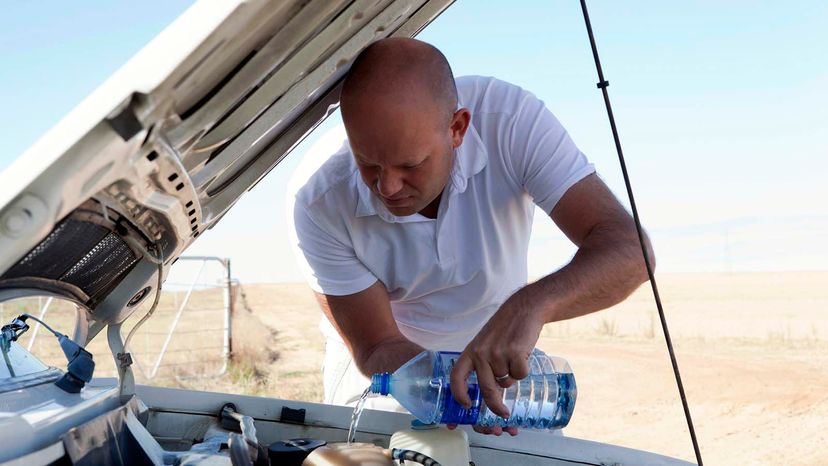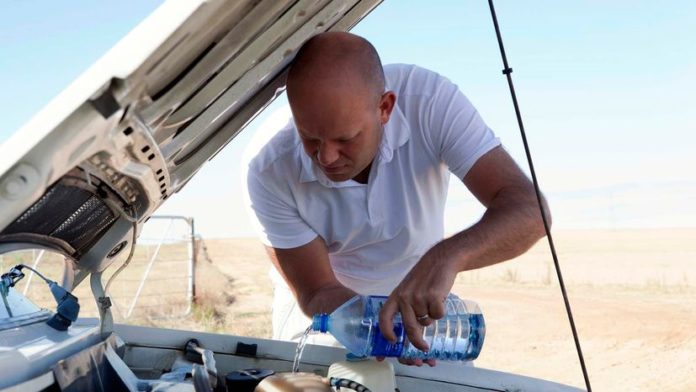\”

You\’ve been watching the needle creeping higher over the last few miles. Now the temperature light on your car\’s dashboard display is on. Your car is overheating and you\’re in the middle of nowhere. What are you supposed to do? You have water that you keep in the trunk for emergencies. This, my friend, is that emergency.
While it\’s best to use a mix of coolant and water in your radiator, water alone will do in a pinch. But it\’s important to add it properly. Here\’s how to make do with water alone until you can get to a gas station or garage.
1. Pull Over Somewhere Safe
Turn off your car and let the engine cool down. This can take a few minutes on a cold day or about a half-hour on a hot day. You want it to be cool enough to touch. It definitely should not be steaming when you touch it.
2. Find the Radiator
They\’re located at the front of the engine, just behind the grill. Newer cars helpfully label the radiator cap, and it\’s usually more oval than other circular caps in the engine bay.
3. Remove the Radiator Cap
This is a good time to remind you that the engine really has to be cooled down before you take off the radiator cap. This system is pressurized, and the fluid inside is probably still hot. You do not want to be splashed by scalding fluid. If the engine is cool, you can take the cap off. Use a towel, rag, old T-shirt — whatever you have in the car — to twist off the cap for extra safety.
4. Add the Water
There\’s also an overflow tank, which is a plastic jug inside the engine bay. This is where you want to pour the water. There are markings for minimum (MIN) and maximum (MAX) on this tank. If you\’re pulled over on the side of the road with a water bottle in your hand, it\’s likely that the fluid is near minimum. If your car doesn\’t have an overflow tank, you can pour water into the radiator itself.
5. Replace the Cap
Replace the radiator cap and the overflow tank cap. Start the car and head directly to the nearest place that will sell you coolant to mix with your emergency water in the radiator.
Modern engines run hot, and coolant raises the boiling point of water above 212 degrees Fahrenheit (100 degrees Celsius). You don\’t want to use water alone for long, as it will boil off more quickly and it can corrode the engine. But as the auto experts at NAPA say, "water is better than nothing."
Now That\’s Interesting
What\’s the difference between antifreeze and coolant? Not much, really. Antifreeze does what it says on the label: It keeps the fluid in your coolant system from freezing. When mixed 50/50 with water, it acts as a coolant, raising the boiling temp of water and keeping the engine cool.
Originally Published: Jun 3, 2011
Car Radiator FAQ
Can I use water instead of coolant?
Using a coolant in your vehicle’s radiator is best to prevent overheating. However, you can use water in a pinch if you don\’t have any. Just be mindful that water boils quicker than coolant, so you’ll want to change it out as soon as possible.
Where do I put water when my car overheats?
You need to put the water in the radiator by removing the pressure cap once your vehicle cools down. You can also add the water to the coolant reservoir or recovery tank if your car is overheating to the point where there’s steam.
What liquid is used in car radiators to prevent overheating?
Coolant is the most effective liquid used to prevent vehicles from overheating. You can use water as well in case of emergency or mix them using a 60/40 ratio.
What are the signs of low coolant?
All cars have an icon on their dashboard that indicates if it is overheating or low on coolant. Another sign of low coolant is steam coming out of the engine when you pop the hood. It’s best if you regularly check the level to be preventative.












